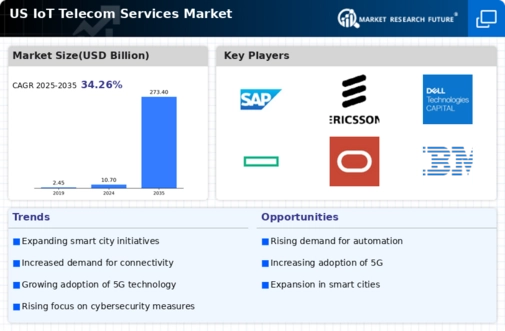The competitive landscape of the US IoT Telecom Services Market is characterized by rapid innovation and an influx of new technologies that enhance connectivity and enable advanced data analytics. As organizations increasingly adopt Internet of Things solutions to improve operations and customer experiences, telecom service providers are positioning themselves to meet the rising demand. Market players are focusing on developing end-to-end IoT solutions that integrate with existing systems and infrastructure, while also ensuring scalability and security.
The market is dynamic, with various players vying for a share, leading to collaborations, partnerships, and even mergers and acquisitions, all aimed at enhancing service offerings and expanding market reach. In the context of the US IoT Telecom Services Market, SAP distinguishes itself through its comprehensive suite of IoT services and software that enable businesses to leverage their existing data and optimize operations through analytics and automation.
The company's strong presence in areas such as supply chain management and enterprise resource planning provides it with a unique advantage, as it allows for seamless integration of IoT solutions with existing enterprise applications. SAP has established multiple strategic alliances, enhancing its reach and implementation capabilities across various sectors of the economy. The company's robust technological infrastructure bolsters its service reliability and overall customer satisfaction, while the focus on delivering highly customized IoT applications resonates well with the diverse needs of US businesses, reinforcing its competitive position in the marketplace.
Ericsson holds a significant place in the US IoT Telecom Services Market, driving innovation in connectivity solutions that empower industrial transformation and smart infrastructure development. The company offers a variety of key products and services, including its IoT Accelerator platform, which provides enterprises with an end-to-end solution to simplify the deployment and management of IoT devices. Ericsson’s strengths lie in its extensive network infrastructure and strong partnerships with various telecom operators, enabling high-quality connectivity across the US. The company has actively pursued mergers and acquisitions to enhance its service portfolio, expanding its capabilities in the IoT landscape.
Through these strategic moves and a commitment to research and development, Ericsson is well-positioned to continue influencing the market with forward-thinking solutions that address the evolving needs of businesses and industries in the US.




















Leave a Comment